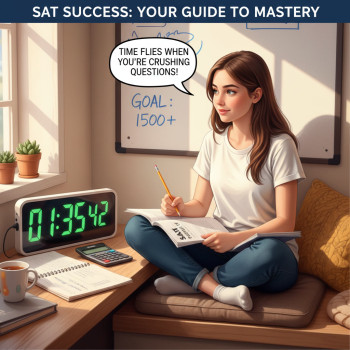Why a Weekend Reset Matters for Your Digital SAT Prep
Weekdays are busy: classes, homework, clubs, and maybe a part-time job. By Friday afternoon your brain is full, and the last thing you want is to stare at a math problem you still haven’t mastered. That’s where the weekend reset comes in. Think of it not as a cram session but as a chance to reorient—restore focus, repair mental energy, and build momentum for the week ahead. A smart weekend reset helps you keep study progress steady without burning out, and it’s especially useful for the Digital SAT because the test experience is different from the old paper SAT: adaptive sections, digital tools, and new practice pathways (like Bluebook and Official SAT Practice).
What the Weekend Reset Will Do for You
- Convert scattered weekday study into concentrated practice with clear goals.
- Give you time to take and review practice tests in the same digital format you’ll see on test day.
- Allow focused skill work—reading, grammar, or specific math topics—without weekday interruptions.
- Recharge mentally with recovery activities so you return to school on Monday ready to learn.
Core Principles: How to Build a Reset That Actually Works
Before we jump into schedules and examples, it helps to agree on a few guiding principles. These are the habits that make every weekend reset predictable and effective.
1. Quality over quantity
Three focused hours on Saturday that include a short adaptive practice section and careful review beats six distracted hours of low-value study. Aim for deliberate practice—work on weaknesses with intent, not on autopilot.
2. Match practice to format
Practice on the same platform or with the same tools you’ll use on test day. The Digital SAT’s Bluebook practice tests and the adaptive format change pacing and navigation—so get comfortable with the interface, highlighting tools, and on-screen calculators.
3. Review with depth
Review more than answers. Ask: Why did I pick that answer? What trap did I fall into? How would I re-approach it next time? This deep review turns mistakes into permanent learning.
4. Plan for recovery
Sleep, movement, and social time are part of studying. Without recovery, focus and retention collapse. Reserve time to fully disconnect at least once during the weekend reset.
The Weekend Reset Blueprint (Proven, Flexible, and Relaxing)
Below is a flexible blueprint you can adapt to a light, medium, or intense weekend depending on how close your test date is, how many hours you logged during the week, and how your energy feels.
Saturday Morning: Calibration & Short Diagnostic
Start with a brief, low-stakes diagnostic to calibrate. The goal is not to produce a score but to identify two or three focus areas for the weekend.
- Duration: 60–90 minutes.
- Task: Take a short adaptive section (e.g., a 30–40 question reading set or one math module) on Bluebook or the digital practice app.
- Outcome: Create a quick list—1 strong area, 1 weak area, 1 careless mistake pattern (time pressure? misreading?)
Saturday Midday: Targeted Skill Work
Now convert that diagnostic into action. Use 60–90 minutes to attack your top weakness with targeted practice and strategy.
- Reading: Practice active annotation and summarization; do 3–4 passages focusing on question types you miss (evidence, inference, vocabulary-in-context).
- Writing & Language: Drill sentence correction strategies (concise phrasing, transition usage, grammar patterns) with 20-30 focused questions.
- Math: Pick one topic (algebra, geometry, or problem solving) and do set-based practice—10–15 questions—with careful step-by-step review.
Saturday Afternoon: Break + Light Review
Take a substantive break (1–2 hours) to move your body, eat, and relax. In the late afternoon, spend 30–45 minutes reviewing flashcards, vocabulary, or formula sheets—something light and confidence-building. This keeps the day productive without frying your brain.
Saturday Evening: Reflection & Planning
Spend 20–30 minutes reviewing what you learned and set a one-week micro-plan. Keep goals specific—”This week I’ll do two 30-minute Khan Academy math drills on linear equations” is better than “practice math.”
Sunday: Full-Length Practice + Deep Review
Sunday is your heavy-lift day. If you can only do one thing the whole weekend, let it be a full adaptive practice test or a long practice session in Bluebook. The power comes from reviewing the entire test thoroughly afterward.
Morning: Full Practice Test (or Long Section)
- Duration: 2.5–4 hours depending on whether you’re doing a full digital test or a long sectional practice. Use the Bluebook practice test for the most authentic experience.
- Tip: Simulate test-day conditions—quiet environment, timed sections, minimal interruptions, and built-in breaks.
Afternoon: Deep Review (the most important part)
Review every incorrect answer and every question you guessed on. Categorize mistakes using this simple table to turn data into action.
| Mistake Type | What to Do | Example |
|---|---|---|
| Concept Error | Review concept notes, do 5 targeted practice questions | Mistook quadratic formula application |
| Careless Error | Slow down, mark double-checks, add 3 “check” steps | Arithmetic mistake in multi-step problem |
| Timing Issue | Do timed mini-drills and practice skipping strategies | Rushed reading questions and missed main point |
| Strategy Gap | Learn a targeted test-taking technique and apply | Don’t know how to use process of elimination for grammar |
After you categorize, pick 3–5 concrete actions to practice during short weekday sessions—these are your carry-over tasks for Monday through Friday.
Late Afternoon: Light Recovery + Micro-Practice
Finish the weekend with a short, fun study activity—flashcards, a quick vocabulary game, or a 20-minute targeted drill. Then deliberately disconnect: go for a walk, cook, or watch something light. Going into Monday with rest helps your brain consolidate what you studied.
Sample Weekend Reset Schedules
Pick a template that fits your life. Adjust start times and durations—consistency matters more than perfection.
Light (4–6 total hours)
- Saturday: 9:00–10:30 am diagnostic & targeted practice; 4:00–4:30 pm review & plan
- Sunday: 9:00–12:00 pm long section; 1:00–2:00 pm review
Moderate (6–10 total hours)
- Saturday: 9:00–10:30 am diagnostic; 11:00–12:30 pm targeted practice; 5:00–5:30 pm reflection
- Sunday: 8:30–12:30 pm full practice test; 2:00–4:00 pm deep review
Intense (10–15 total hours, for peak prep)
- Saturday: 8:30–10:00 am diagnostic; 10:30–1:00 pm targeted drills; 4:00–5:00 pm timed mini-sections
- Sunday: 8:00–12:30 pm full practice; 1:30–4:30 pm deep review; 7:00–8:00 pm strategy refinement
Make Review Actionable: The 3-Point Follow-Up Plan
After every weekend reset, you should leave with three clear follow-up actions for the upcoming week. Keep them simple, measurable, and short.
- Example 1: “Do two 25-minute Khan Academy math modules on systems of equations on Wednesday and Friday.”
- Example 2: “Read one long-form editorial and summarize the main argument on Thursday for 20 minutes.”
- Example 3: “Complete 15 writing & language questions focusing on transitions and concision on Tuesday night.”
Tools and Resources to Use During Your Reset
There are tools designed to mimic the digital testing environment and help you practice smarter—not harder.
- Bluebook practice tests for realistic adaptive testing practice.
- Official SAT Practice (Khan Academy) for personalized practice paths and targeted skill work.
- My Practice score reports to track trends and prioritize weak topics.
- Simple timers and productivity apps for focused sprints (Pomodoro style).
How Personalized Tutoring Fits Naturally
A weekend reset is ideal for integrating targeted tutoring sessions. If you use a service like Sparkl’s personalized tutoring, schedule a 60–90 minute 1-on-1 on Saturday afternoon or Sunday evening—after you’ve done your diagnostic or practice test. That way the tutor sees real data: what you missed, your timing patterns, and which strategies you tried. Sparkl’s tailored study plans and AI-driven insights can help pinpoint the highest-leverage topics to practice during the week and suggest efficient drill sets for your weekday micro-sessions.
Common Weekend Pitfalls and How to Avoid Them
Even the best-laid plans can go sideways. Here are frequent mistakes students make and smarter alternatives.
Pitfall: Weekend becomes an all-or-nothing cram
Fix: Break time into focused blocks with built-in breaks. Use a short morning diagnostic and a longer Sunday practice rather than marathon sessions without structure.
Pitfall: Skipping review
Fix: Make review non-negotiable. It’s better to take one full test and spend three hours reviewing than to take two tests with no review at all.
Pitfall: Only practicing comfortable topics
Fix: Force yourself to do one uncomfortable practice block each weekend. Growth happens where you’re weakest.
Measuring Progress: What to Track and Why
Data gives you clarity. Use a simple weekly tracker—no fancy spreadsheet required—to watch trends. Track three things:
- Practice test scaled score (or sectional percent correct) to watch broad progress.
- Time-per-question averages or skipped question count to identify pacing issues.
- Error categories (concept vs. careless vs. strategy) to guide practice choices.
Real-World Example: How One Student Used a Weekend Reset
Meet Maya (a composite example). She had a busy school week and scored in the low 600s on a practice test in May. Her reset strategy:
- Saturday morning: 60-minute reading diagnostic—discovered she lost points on inference questions.
- Saturday afternoon: 90 minutes of targeted reading drills and note-taking strategies; summarized two passages aloud.
- Sunday: Full Bluebook practice test under timed conditions; spent three hours reviewing categories of mistakes and practiced 10 similar inference questions.
- Week follow-up: Two 30-minute weekday sessions focusing on inference and vocabulary-in-context.
After six weeks of consistent weekend resets and weekday micro-practice, Maya’s sectional percent on reading rose, and she felt more in control of time and pacing during practice tests.
Personal Well-Being: Sleep, Nutrition, and Movement
Your brain is the engine that stores and retrieves knowledge. Treat it well. Prioritize at least 8 hours of sleep on the night after your full practice test, hydrate, and include short movement breaks during long study blocks (5–10 minutes every hour). Even a 20-minute walk after a review session can boost consolidation and reduce stress.
When to Intensify Your Weekend Reset
As your test date approaches (4–6 weeks out), shift your weekend reset toward full-length tests and tighter reviews. In the final two weeks, simulate a full test every weekend, sharpen timing strategies, and ensure mental recovery to avoid burnout right before test day.
Final Checklist: Your Next Weekend Reset
- Plan a Saturday diagnostic that reveals 2–3 focus areas.
- Schedule a targeted practice block for those areas (60–90 minutes).
- Take a full or long practice test on Sunday in Bluebook.
- Spend at least 2–3 hours doing deep review—categorize mistakes and write 3 follow-up actions.
- Plan weekday micro-practice tasks tied directly to your review.
- Include one real recovery block—no study allowed.
Closing Thought: Consistency Trumps Intensity
The most powerful effect of a weekend reset is how it converts irregular study into a steady, sustainable habit. Small, smart decisions each weekend add up. If you occasionally use targeted support—like a Sparkl tutor who offers 1-on-1 guidance and AI-driven insights—you can accelerate those gains by making sure each weekend’s practice is precise and efficient. But the core remains the same: practice in the right format, review deeply, plan your week, and rest intentionally. Do that for a few months and you’ll walk into test day calm, confident, and ready to perform.
Parting Prompt
Before you close this tab: write down three things you want to accomplish this weekend’s reset—one diagnostic goal, one skill target, and one recovery plan. Keep that list where you can see it, and use it to guide a reset that’s productive, peaceful, and perfectly doable.












No Comments
Leave a comment Cancel